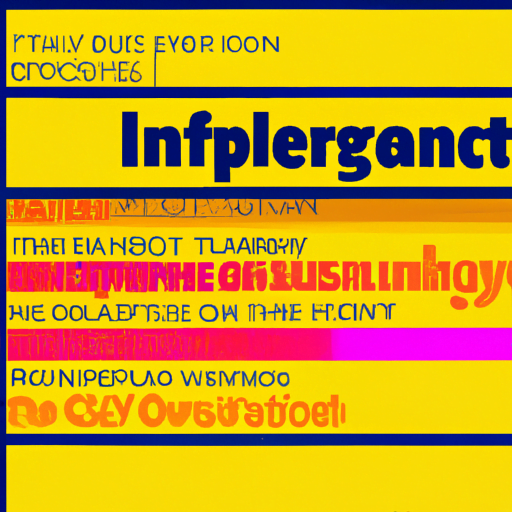
-
Table of Contents
- The Influence of Typography in User Experience Design
- The Importance of Typography in User Experience Design
- Best Practices for Typography in User Experience Design
- 1. Choose Fonts Wisely
- 2. Pay Attention to Font Sizes and Spacing
- 3. Consider Accessibility
- Real-World Examples
- 1. Apple
- 2. Medium
- 3. Airbnb
- Summary
The Influence of Typography in User Experience Design

Typography plays a crucial role in user experience design, shaping the way users perceive and interact with digital interfaces. From websites to mobile applications, the choice of fonts, sizes, and spacing can significantly impact how users engage with a product. In this article, we will explore the influence of typography in user experience design, examining its importance, best practices, and real-world examples.
The Importance of Typography in User Experience Design
Typography is more than just selecting a font; it is about creating a visual hierarchy, enhancing readability, and conveying the brand’s personality. Here are some key reasons why typography is essential in user experience design:
- Readability: The primary purpose of typography is to make content readable. Well-designed typography ensures that users can easily consume information without straining their eyes or losing interest.
- Visual Hierarchy: Typography helps establish a visual hierarchy, guiding users through the content and highlighting important elements. By using different font sizes, weights, and styles, designers can direct users’ attention to specific areas.
- Brand Identity: Typography plays a crucial role in expressing a brand’s personality and values. Consistent typography across different touchpoints helps create a cohesive brand experience and fosters brand recognition.
- Emotional Impact: Different fonts evoke different emotions. Typography can convey a sense of professionalism, playfulness, elegance, or urgency, influencing how users perceive and connect with a product.
Best Practices for Typography in User Experience Design
Now that we understand the importance of typography let’s explore some best practices for incorporating typography into user experience design:
1. Choose Fonts Wisely
The choice of fonts is critical in setting the tone and establishing the brand’s identity. When selecting fonts, consider the following:
- Legibility: Prioritize legibility over aesthetics. Ensure that the chosen fonts are easy to read, even at small sizes or on different devices.
- Contrast: Create contrast between different elements by using fonts with varying weights or styles. This helps establish a visual hierarchy and improves readability.
- Consistency: Use a limited number of fonts throughout the interface to maintain consistency. Mixing too many fonts can create a chaotic and unprofessional look.
2. Pay Attention to Font Sizes and Spacing
Font sizes and spacing significantly impact readability and user experience. Consider the following guidelines:
- Responsive Design: Ensure that font sizes and spacing adapt to different screen sizes and resolutions. This guarantees a consistent and comfortable reading experience across devices.
- Hierarchy: Use larger font sizes for headings and subheadings to establish a clear visual hierarchy. Smaller font sizes can be used for body text and less important elements.
- Line Length: Optimize line length to improve readability. Long lines can be tiring to read, while short lines can feel fragmented. Aim for around 50-75 characters per line.
- Whitespace: Incorporate ample whitespace between lines, paragraphs, and elements to enhance readability and create a sense of visual balance.
3. Consider Accessibility
Typography should be accessible to all users, including those with visual impairments. Consider the following accessibility guidelines:
- Contrast: Ensure sufficient contrast between text and background colors to accommodate users with low vision or color blindness. Tools like the Web Content Accessibility Guidelines (WCAG) provide specific contrast ratio recommendations.
- Font Styles: Avoid using fonts with intricate or decorative styles for large blocks of text, as they can be difficult to read for users with dyslexia or other reading difficulties.
- Font Size: Provide options for users to adjust font sizes according to their preferences. This can be achieved through responsive design or by offering font size customization settings.
Real-World Examples
Let’s examine some real-world examples that demonstrate the impact of typography in user experience design:
1. Apple
Apple is known for its clean and minimalist design aesthetic, and typography plays a significant role in their user experience. The company uses the San Francisco font, which was specifically designed for legibility on digital screens. The font’s clean lines and generous spacing contribute to a modern and sleek look, while its various weights and styles help establish a clear visual hierarchy.
2. Medium
Medium, a popular online publishing platform, places a strong emphasis on typography to enhance the reading experience. They use a combination of serif and sans-serif fonts to create contrast and establish a visual hierarchy. The generous line spacing and ample whitespace contribute to a comfortable reading experience, allowing users to focus on the content without distractions.
3. Airbnb
Airbnb’s typography reflects the brand’s friendly and inclusive personality. They use the Cereal font, which combines rounded edges with a clean and modern look. The font’s versatility allows Airbnb to convey a sense of warmth and approachability while maintaining a professional appearance. The careful selection of font sizes and spacing ensures readability across different devices and screen sizes.
Summary
Typography plays a vital role in user experience design, influencing readability, visual hierarchy, brand identity, and emotional impact. By choosing fonts wisely, paying attention to font sizes and spacing, and considering accessibility, designers can create engaging and user-friendly interfaces. Real-world examples from companies like Apple, Medium, and Airbnb demonstrate the power of typography in shaping user experiences. Incorporating these best practices and understanding the influence of typography will undoubtedly lead to more effective and impactful user experience designs.
